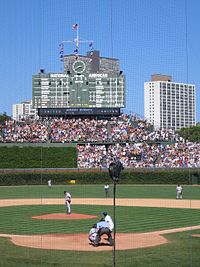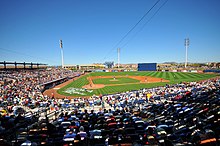
The original Yankee Stadium was a stadium located in the Bronx in New York City. It was the home ballpark of the New York Yankees, one of the city's Major League Baseball franchises, from 1923 to 2008, except for 1974–1975 when the stadium was renovated. It hosted 6,581 Yankees regular season home games during its 85-year history. It was also the home of the New York Giants National Football League (NFL) team from October 21, 1956 through September 23, 1973. The stadium's nickname, "The House That Ruth Built", is derived from Babe Ruth, the baseball superstar whose prime years coincided with the stadium's opening and the beginning of the Yankees' winning history. It has often been referred to as "The Cathedral of Baseball". Since the opening of the new Yankee Stadium in 2009, it is sometimes retroactively referred to as Old Yankee Stadium to distinguish it from the current one.

Wrigley Field is a stadium on the North Side of Chicago, Illinois. It is the ballpark of Major League Baseball's Chicago Cubs, one of the city's two MLB franchises. It first opened in 1914 as Weeghman Park for Charles Weeghman's Chicago Whales of the Federal League, which folded after the 1915 baseball season. The Cubs played their first home game at the park on April 20, 1916, defeating the Cincinnati Reds 7–6 in 11 innings. Chewing gum magnate William Wrigley Jr. of the Wrigley Company acquired the Cubs in 1921. It was named Cubs Park from 1920 to 1926, before being renamed Wrigley Field in 1927. The stadium currently seats 41,649 people and is the second stadium to be named Wrigley Field, as a Los Angeles ballpark with the same name opened in 1925.

The Green Monster is a popular nickname for the 37-foot-2-inch-high (11.33 m) left field wall at Fenway Park, home to the Boston Red Sox of Major League Baseball. The wall is 310 feet (94 m) from home plate and is a popular target for right-handed hitters.
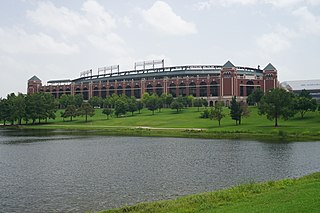
Choctaw Stadium, formerly Globe Life Park, is an American multi-purpose stadium in Arlington, Texas, between Dallas and Fort Worth. Originally built as a baseball stadium, it was home to the Texas Rangers of Major League Baseball and the Texas Rangers Baseball Hall of Fame from 1994 through 2019, when the team vacated the stadium for Globe Life Field. It was constructed as a replacement for nearby Arlington Stadium and opened in April 1994 as The Ballpark in Arlington.

Oriole Park at Camden Yards, commonly known as Camden Yards, is a baseball stadium in Baltimore, Maryland. It is the ballpark of Major League Baseball's Baltimore Orioles, and the first of the "retro" major league ballparks constructed during the 1990s and early 2000s. It was completed in 1992 to replace Memorial Stadium. The stadium is in downtown Baltimore, a few blocks west of the Inner Harbor in the Camden Yards Sports Complex.

Citizens Bank Park is a baseball stadium located in Philadelphia, Pennsylvania, in the city's South Philadelphia Sports Complex. It is the ballpark of Major League Baseball's Philadelphia Phillies. The stadium opened April 3, 2004, and hosted its first regular season baseball game on April 12 of the same year, with the Phillies losing to the Cincinnati Reds, 4–1. It is named after Citizens Financial Group.
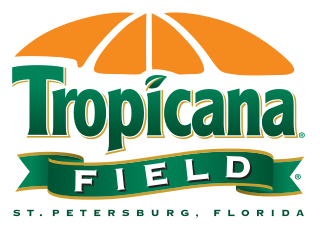
Tropicana Field is a multi-purpose domed stadium located in St. Petersburg, Florida, United States. The stadium has been the ballpark of the Tampa Bay Rays of Major League Baseball (MLB) since the team's inaugural season in 1998. The stadium is also used for college football, and from December 2008 to December 2017 was the home of the St. Petersburg Bowl, an annual postseason bowl game. The venue is the only non-retractable domed stadium in Major League Baseball, making it the only year-round indoor venue in MLB. Tropicana Field is the smallest MLB stadium by seating capacity when obstructed-view rows in the uppermost sections are covered with tarps as they are for most Rays games.

The Polo Grounds was the name of three stadiums in Upper Manhattan, New York City, used mainly for professional baseball and American football from 1880 through 1963. The original Polo Grounds, opened in 1876 and demolished in 1889, was built for the sport of polo. Bound on the south and north by 110th and 112th streets and on the east and west by Fifth and Sixth (Lenox) avenues, just north of Central Park, it was converted to a baseball stadium when leased by the New York Metropolitans in 1880.

Guaranteed Rate Field, formerly Comiskey Park and U.S. Cellular Field, is a baseball stadium located on the South Side of Chicago, Illinois, United States. It serves as the ballpark of the Chicago White Sox, one of the city's two Major League Baseball (MLB) teams, and is owned by the state of Illinois through the Illinois Sports Facilities Authority. Completed at a cost of US$137 million, the park opened as Comiskey Park on April 18, 1991, taking its name from the former ballpark at which the White Sox had played since 1910.

Griffith Stadium stood in Washington, D.C., from 1911 to 1965, between Georgia Avenue and 5th Street, and between W Street and Florida Avenue NW.

National League Park, commonly referred to as the Baker Bowl after 1923, was a baseball stadium and home to the Philadelphia Phillies from 1887 until 1938, and first home field of the Philadelphia Eagles from 1933 to 1935. It opened in 1887 with a capacity of 12,500, burned down in 1894, and was rebuilt in 1895 as the first ballpark constructed primarily of steel and brick, and first with a cantilevered upper deck. The ballpark's first base line ran parallel to Huntingdon Street; right field to center field parallel to North Broad Street; center field to left field parallel to Lehigh Avenue; and the third base line parallel to 15th Street. The stadium was demolished in 1950.

Crosley Field was a Major League Baseball park in Cincinnati, Ohio. It was the home field of the National League's Cincinnati Reds from 1912 through June 24, 1970, and the original Cincinnati Bengals football team, members of the second (1937) and third American Football League (1940–41). It was not the original home of the current NFL franchise of the same name: the home of those Bengals in 1968 and 1969 was nearby Nippert Stadium, located on the campus of the University of Cincinnati. Crosley Field was on an asymmetrical block bounded by Findlay Street (south), Western Avenue, Dalton Avenue (east), York Street (north) and McLean Avenue (west) in the Queensgate section of the city. Crosley has the distinction of being the first major-league park with lights for playing night games.

Bleachers, or stands, are raised, tiered rows of benches found at sports fields and other spectator events. Stairways provide access to the horizontal rows of seats, often with every other step gaining access to a row of benches.

A ballpark, or baseball park, is a type of sports venue where baseball is played. The playing field is divided into the infield, an area whose dimensions are rigidly defined, and the outfield, where dimensions can vary widely from place to place. A larger ballpark may also be called a baseball stadium because it shares characteristics of other outdoor stadiums.
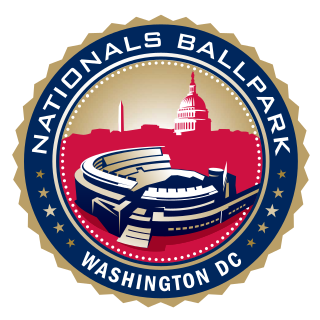
Nationals Park is a baseball stadium along the Anacostia River in the Navy Yard neighborhood of Washington, D.C. It is the ballpark of Major League Baseball's Washington Nationals. Since its completion in 2008, it was the first LEED-certified green major professional sports stadium in the United States.

Ground rules are rules applying to the field, objects on and near it, and special situations relating to them, in the game of baseball. Major League Baseball has defined a set of "universal ground rules" that apply to all MLB ballparks; individual ballparks have the latitude to set ground rules above and beyond the universal ground rules, as long as they do not directly contradict each other. Additionally, a set of universal ground rules exists for the six MLB stadiums with retractable roofs, with the individual ballparks able to set additional rules.
Bradner Stadium is a multi-purpose stadium in Olean, New York. The stadium, which can accommodate both baseball and football, served as home to minor-league baseball teams including the Olean Oilers and Olean Yankees. The stadium was built in 1926 and was substantially renovated in 2013. It holds 4,000 people and primarily serves as the home stadium of the NYCBL Olean Oilers collegiate baseball team for over 20 summer games as well as the Olean High School and Archbishop Walsh football teams in the fall. The stadium accommodates several community events as well.
The history of Wrigley Field, the home of the Chicago Cubs of Major League Baseball's National League, begins well before the Cubs played their first game in that venue.
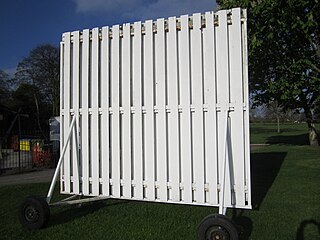
In cricket, a sight screen is an apparatus, often comprising wooden or poly-carbonate slats, or cloth sheeting, on a large frame made of wood or another material, that is positioned alongside the cricket field to provide the batsmen a clear view of the bowler's deliveries, such that distractions including spectators do not disturb the batsman.
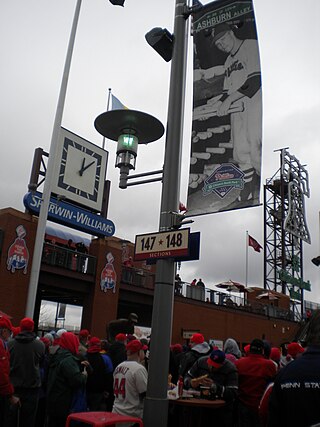
Ashburn Alley is the open concourse behind center field at Citizens Bank Park, home of the Philadelphia Phillies. It is named after Hall of Famer Richie Ashburn, Phillies center fielder from 1948 to 1959, and was also a long time broadcaster for the Phillies from 1963 until his death in September 1997. Ashburn Alley spans from the left field gate to "The Yard" kids area, and features a "street-fair" like atmosphere before and during a game.
